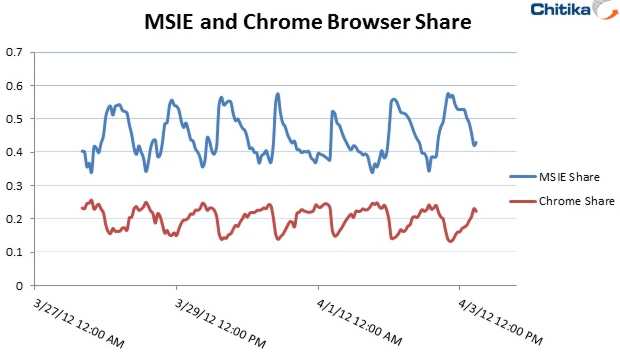| A Browser For Work and Another For Play |
| Written by Janet Swift | |||
| Monday, 16 April 2012 | |||
|
People appear to switch browsers according to when, where and how they surf the web. What are the implications of this behavior? Recently we reported StatCounter’s claim that users appear to switch from Internet Explorer to Chrome at the weekends. Now online ad network and data analytics firm, Chitika, has analyzed data from impressions in the US and Canada in a week-long period (March 27 to April 4, 2012) and found a pattern that suggests that users make the same switch, from IE to Chrome, in the evenings.
Chitika’s chart never shows Chrome usage exceeding (or even approaching the same level as) Internet Explorer; according to its figures Chrome has a peak share of 25%, compared to MSIE’s 55% average peak use, and it doesn’t show the difference between the weekend and weekdays that it set out to investigate. However, there is a clear regular trend during the day: MSIE regularly exhibits peak hours of use from the beginning of the day (EST) towards the lunch hour and early afternoon, seeing its share of the overall web browsing market sit comfortably above 50% during this time period. Chrome on the other hand sees a pickup in usage later in the afternoon, and eventually maxing out in the later hours of the day as people get out of work and the evening progresses. After describing this pattern Chitika states: For Publishers and Advertisers, this data is significant for a couple of reasons. First it exhibits the reality that consumer behavior is often a function of the constraints applied to it – in this case, the corporate standard of Microsoft Windows and MSIE in the workplace. Second it showcases how high levels of variability can occur within markets on a micro scale. To be aware of these minor shifts and readily able to adapt them can drive revenues and maximize ROI. This finding is also important for web-developers but for different reasons. You might think the obvious one is the need to provide a consistent experience irrespective of which browser is being used. But no, the fact that users choose an alternative browser when they are not constrained by company policy delivers the opposite message. As we repeatedly mention on I Programmer, Microsoft's refusal to embrace WebGL means that IE users don't get the full potential of the web. You might think that high IE usage numbers would imply that you shouldn't use WebGL but given that so many user switch to Chrome when the get the chance, and in particular when they are having fun, using WebGL looks a lot safer bet.
So let's keep IE for work and go play with Chrome.
More InformationChitika Study: MSIE Sees Greatest Traffic During Work Day; Chrome Picks up in Evenings Related ArticlesChrome 18 Now With 2D GPU Graphics
Comments
or email your comment to: comments@i-programmer.info
To be informed about new articles on I Programmer, subscribe to the RSS feed, follow us on Google+, Twitter, Linkedin or Facebook or sign up for our weekly newsletter.
|
|||
| Last Updated ( Monday, 16 April 2012 ) |



